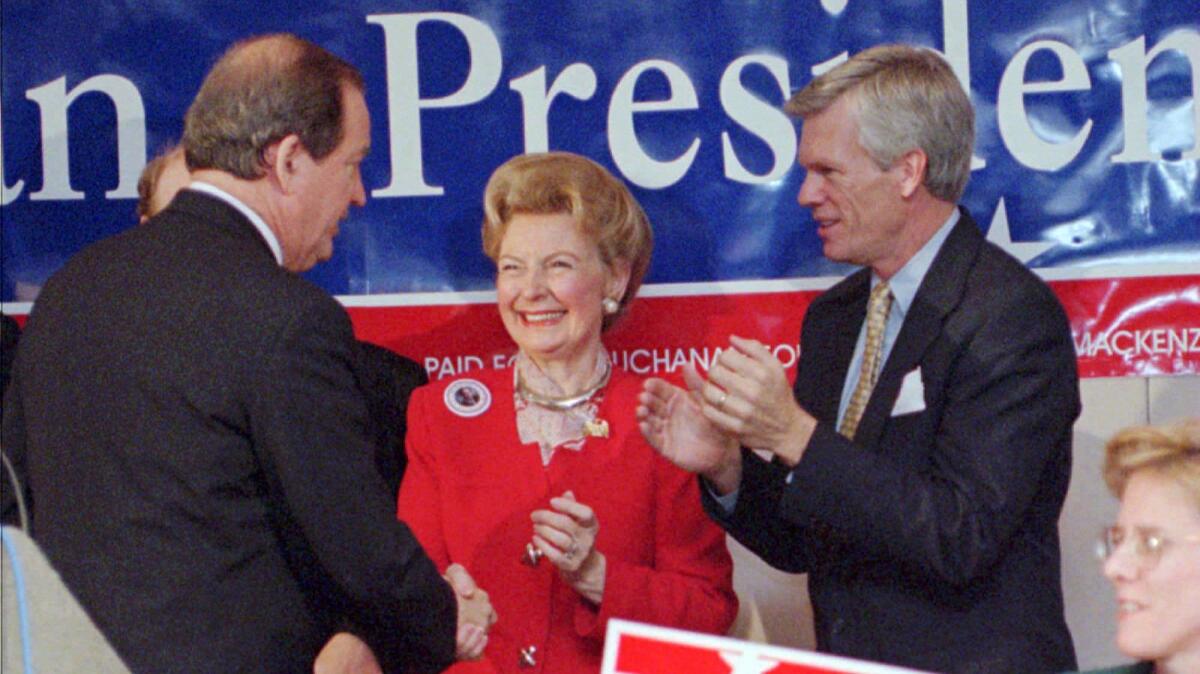Op-Ed: Phyllis Schlafly: The antifeminist who wanted a job in the Reagan administration

The death this week of Phyllis Schlafly, the arch-anti-feminist and antigay activist, calls to mind a harrowing episode buried deep in the archives of the Ronald Reagan Presidential Library in Simi Valley.
Schlafly founded Stop ERA in 1972, an advocacy group later renamed Eagle Forum whose principal mission was to derail the proposed Equal Rights Amendment to the Constitution. She succeeded by sowing fears that women would be denied child custody or alimony and be forced into combat and same-sex bathrooms. Schlafly, a Roman Catholic, also succeeded by persuading evangelicals to abandon their historic advocacy for womenâs rights. (Rosalynn Carter has said that the failure to secure ratification of the ERA was the biggest disappointment of her husbandâs presidency.)
Schlafly, who had supported Barry Goldwater’s campaign for the presidency in 1964, initially ... harbored doubts that Reagan was sufficiently conservative.
It is no small irony that Schlafly fashioned an entire career out of traveling the country instructing women to stay home. She would often open her remarks by saying that her husband had granted her permission to address the gathering.
Schlafly, who had supported Barry Goldwaterâs campaign for the presidency in 1964, initially backed Philip Crane for the Republican nomination in 1980 because she harbored doubts that Reagan was sufficiently conservative. Eventually, she rallied behind Reagan and evidently believed that her advocacy on his behalf entitled her to a plum appointment in his administration.
On election day 1980, before the results of the election were in, Joseph Coors, apparently at the behest of Schlafly, sent a letter to the Reagan-Bush transition team. Coors, the beer tycoon who had bankrolled the Heritage Foundation, urged that Schlafly be placed âin an important spot in the Reagan government.â
Schlafly had her eye on a Cabinet post as secretary of Education or a senior position in the Defense Department. She organized a letter campaign on her behalf. âI highly recommend that Phyllis Schlafly be considered for either the position of Secretary of Education or Under Secretary of Defense for Policy,â Jay Van Andel, co-founder of Amway, wrote to the head of the transition team.
Schlafly continued her efforts into the early days of the Reagan administration, but to no effect. Undeterred, she organized yet another campaign several months later to have herself appointed to the Supreme Court seat vacated by the retiring Potter Stewart in June 1981. Reagan, however, who had promised to appoint the first woman to the high court, chose Sandra Day OâConnor instead.
I have no way of knowing how seriously these self-nomination campaigns were received by the Reagan White House, but I imagine that the endorsement of such deep-pocketed Republican donors as Coors and Van Andel caught someoneâs attention. We can only guess how Schlafly â a supporter of taxpayer funds for religious schools, who believed that evolution is âindoctrination,â who insisted that âthe true foundation of our constitutional republic is Christianityâ and who believed that the movement combating climate change was a redoubt for communists â would have functioned as secretary of Education. On defense, Schlafly once remarked that âthe atomic bomb is a marvelous gift that was given to our country by a wise God.â As for the Supreme Court, itâs safe to say that at least some of her decisions would have differed from those of OâConnor, certainly including the latterâs compromise rulings on abortion.
Schlafly, having failed in her previous crusades of self-promotion, mounted one last effort early in 1985, at the beginning of Reaganâs second term. Once again, Coors interceded on her behalf.
He sent a letter hailing Schlafly as âa great Americanâ and suggesting that she be appointed chair of the Commission on the Bicentennial of the U.S. Constitution. The Reagan administration, apparently concluding that Schlafly, an attorney, could do little damage on the largely ceremonial commission, appointed her as a member (not chair) in 1985.
Reagan made several questionable appointments during his presidency â the ethically challenged Edwin Meese III as attorney general, for instance, or the environmentally hostile James Watt as secretary of the Interior and Anne Gorsuch Burford as head of the Environmental Protection Agency. But I suspect that installing Phyllis Schlafly as secretary of Education or in the Defense Department, much less as Supreme Court justice, would have made those appointments look sagacious by comparison.
Randall Balmer is chair of the religion department at Dartmouth College and the author of âRedeemer: The Life of Jimmy Carter.â
Follow the Opinion section on Twitter @latimesopinion and Facebook
More to Read
A cure for the common opinion
Get thought-provoking perspectives with our weekly newsletter.
You may occasionally receive promotional content from the Los Angeles Times.









